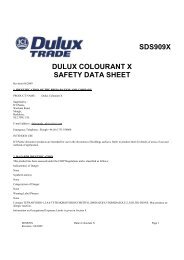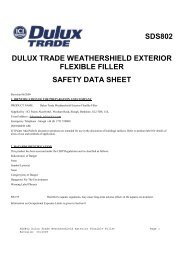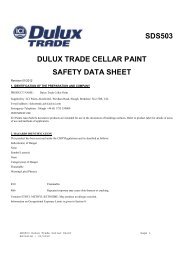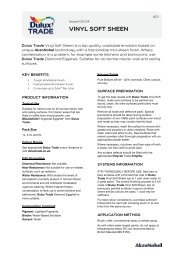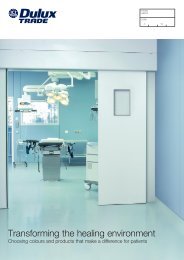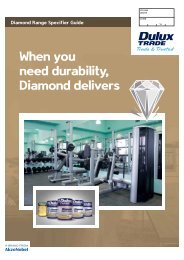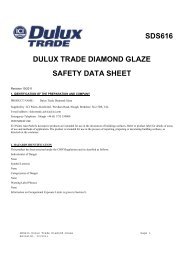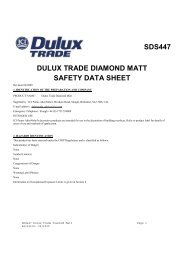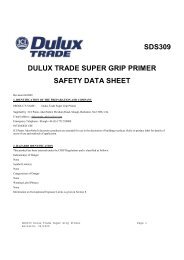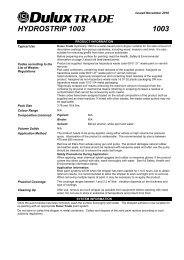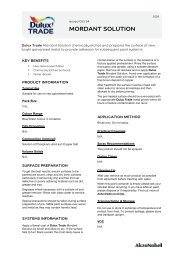SDS546 Dulux Trade Pyroshield Durable Eggshell
SDS546 Dulux Trade Pyroshield Durable Eggshell
SDS546 Dulux Trade Pyroshield Durable Eggshell
- No tags were found...
You also want an ePaper? Increase the reach of your titles
YUMPU automatically turns print PDFs into web optimized ePapers that Google loves.
8. EXPOSURE CONTROLS/PERSONAL PROTECTIONEXPOSURE LIMIT VALUESHAZARDOUS INGREDIENTLTEL (8hrTWA) ppmLTEL (8hrTWA) mg/m3STEL (15mins) ppmSTEL (15mins) mg/m3NotesNO SUBSTANCES REQUIRED TO BE LISTED IN THIS SECTIONOEL - Occupational Exposure LimitsWEL - Workplace Exposure LimitSUP - Manufacturer's recommended LimitLTEL - Long-term Exposure Limit.TWA - Time weighted AverageSTEL - Short term Exposure Limit (15mins)sk - Risk of absorption through unbroken skinsen - Respiratory sensitiserrd - Figure quoted is for Respirable dustid - Figure quoted is for Inhalable dustFurther guidance on WELs and OELs, and on occupational exposure to harmful materials (including mixed exposures) is givenin HSE Guidance Note EH40.EXPOSURE CONTROLSBefore commencing work, ensure that a COSHH Assessment has been carried out. All personal protective equipment, includingrespiratory protective equipment, used to control exposure to hazardous substances must be selected to meet the requirements oflocal regulations.RESPIRATORY PROTECTION: Avoid the inhalation of vapour, particulates and spray mist. Where reasonably practicable, thisshould be achieved by the use of local exhaust ventilation and good general ventilation. If this is not sufficient to maintainconcentrations of particulates and solvent vapour below the occupational exposure limit, respiratory protection must be worn.The selection of respiratory equipment should be in accordance with BS529:2005. Recommendations for the selection, use andmaintenance of Respiratory Equipment, and the current certificates of approval are issued annually by the Health and SafetyExecutive.For solvent-based products, consider using water-based products as alternatives, where equivalent products exist. Work only inplaces of good ventilation. Inside always keep doors and windows fully open during application and drying. When applyingsolvent-based products by brush or roller to large surface areas inside, or using in small confined spaces, the wearing of airsupplied breathing apparatus will be necessary except that when applying for short periods only, a cartridge mask may be wornproviding the filter is changed regularly. Do not spray any product unless directed to do so on the container. The principalhazards associated with paint spraying are health hazard from inhalation of vapours and spray mist, and fire risk. When applyingwater-based paints by spray inside or in confined spaces, wearing a cartridge mask of Assigned Protection Factor 40 x OEL forparticulates is recommended. This should be confirmed by your COSHH assessment. Contact your merchant about masks. Whenapplying solvent-based paints by spray, in case of insufficient ventilation, the wearing of air-fed respiratory equipment willalways be necessary. Refer to your COSHH assessment. When spraying solvent based products it is possible to build up anexplosive or flammable atmosphere: refer to Guidance Note EH9 from the HSE or advice on good practice. All respiratoryequipment must be suitable for the purpose and meet an appropriate standard approved by the HSE. Refer to BS529:2005HAND PROTECTION: Wear suitable gloves for protection against materials in section 3.When skin exposure may occur, advice should be sought from glove suppliers on appropriate types and usage times for thisproduct. The instructions and information provided by the glove supplier on use, storage, maintenance and replacement must befollowed.EYE PROTECTION: Eye protection designed to protect against liquid splashes should be worn.SKIN PROTECTION: Cotton or cotton/synthetic overalls or coveralls are normally suitable. Grossly contaminated clothingshould be removed and the skin washed with soap and water or a proprietary skin cleaner.FLATTING: Protective gloves should be worn to avoid the risk of skin irritation. When surfaces are to be prepared for painting,account should be taken of the age of the property and the possibility that lead pigmented paint might be present. There is apossibility that ingestion or inhalation of scrapings or dust arising from the preparation work could cause health effects As aworking rule you should assume that this will be the case if the age of the property is pre 1960.Where possible wet flatting or chemical stripping methods should be used with surfaces of this type to avoid the creation of dust.When dry flatting cannot be avoided, and effective local exhaust ventilation is not available, it is recommended that a dustrespirator is worn, that is approved for use with lead dusts, and its type selected on the basis of the occupational hygiene<strong>SDS546</strong> <strong>Dulux</strong> <strong>Trade</strong> <strong>Pyroshield</strong> <strong>Durable</strong> <strong>Eggshell</strong> Page 3Issued: 06/2011




